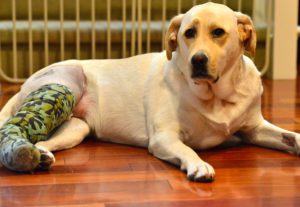Why is My Dog Limping in Portsmouth, NH
Limping is a common sign of discomfort in the bones or muscles of your dog, but can have a variety of causes. In the article below we will discuss some of the common causes and tips for your vet visit. It’s always best to have your pet examined by a veterinarian if you notice “Fido” limping.
Assessing the situation
When your pet starts limping, take a few minutes to assess the situation to help you best decide what to do next. In cases of acute lameness where the pet is not using the limb at all or is in noticeable pain, they should be seen by their veterinarian same to next day. No matter how gentle your dog is or how much you trust them, take precautions if your pet is in pain. Even the most docile of pets can respond by nipping or biting when they are injured or uncomfortable. For pets in notable pain, avoid touching or picking up the pet in that area. Small dogs may feel more comfortable being scooped up in their dog bed or a large blanket. If you need to assist your pet in walking, a towel can be used as a sling to guide your pet up and support them as they move.
The degree of lameness may look differently in your pet, but here are some basic guidelines to consider. With mild lameness your pet may be only intermittently favoring the leg by occasionally holding it up or sitting or laying in a different position than they normally would. They often will shift their weight from the injured leg to the others to feel more stable. When your pet is favoring the affected limb noticeably but will still use the leg normally on occasion, this would be considered moderate lameness. It is considered to be severe lameness when your dog is not using the leg at all or will only “toe touch” sporadically. Moderate and severe signs warrant an appointment to see your veterinarian.

Some information you want to gather in preparation for your vet visit is:
1) Have you performed a visual inspection to ensure that nothing is lodged between the toes or for signs of injury or trauma?
2) How long has this been going on and which leg(s) are affected?
3) Was there a known trauma? Or did your pet just wake up lame?
4) Does your pet appear stiff in the morning and then more comfortable as the day goes on? Does temperature or weather play a factor on the frequency, duration, or severity?
5) Has this been an issue in the past? What was the outcome?
6) Is your pet on flea and tick prevention? Which brands? And have you seen any ticks on them this year? Have inspected your pet for ticks?
7) Gather any medications your pet is on and know the names, dosages, and how often they are given. If you already have pain medication for your pet from a previous issue, call your vet’s office before administering as pain medication may make it difficult to determine where the site or source of pain is during examination. Over the counter remedies and medications should be avoided unless directed by your veterinarian. They may interact with medicine your vet wants to use or mask your pet’s response to the orthopedic exam.
Common Causes
Musculoskeletal
The most obvious causes are those involving the bones and muscles. Fractures of the bone can present differently depending on the severity. Typical fractures where the bone fragments have separated commonly show severe signs, but if there are hairline fractures without displacement, your pet may only have mild or moderate discomfort. In general, these are caused by trauma, but if the bone itself is not healthy it may not take much to traumatize it. Poor bone density could be caused by infections, cancer, systemic disease, or prior injuries.
Arthritis is a common cause of limping in older pets. Our geriatric dogs may feel very stiff in the morning but as the day goes on their movements are more fluid. They may also play hard and then afterwards feel more uncomfortable. This most commonly affects the hips and knees but can be seen anywhere including the neck and spine.
Sprains and strains are common and often resolve with strict rest. Discuss with your veterinarian if additional instructions and/or medications for comfort are necessary.-.
Some common orthopedic problems seen in dogs are luxating patellas, where the kneecap pops in and out of place, and a cranial cruciate tear, also known as the “ACL” in humans. The ligament is one of the main stabilizers of the knee and is one of the most common ligament injuries in pets. Keeping your pets active and fit can help reduce your risk of orthopedic problems.

Neurological
Conditions involving the nervous system of your pet can present as orthopedic ones. While there are numerous causes, there are some things to look out for. Paralysis, a complete lack of use of one or more limbs, or paresis, a partial paralysis or weakness, may be indicators of neurologic disease. Acute paralysis or paresis may be an emergency situation for your pet. The signs could even be more subtle and mimic mild or moderate lameness. If you notice the nails on one or more feet being worn down in a different pattern or on top, this may mean your pet is dragging its feet. Abnormal movement of the legs or feet may also be seen. Your veterinarian can help better determine your pet’s limp is or may be neurologic in nature.
Infections
Bacterial infections in the bone or soft tissue can be painful, but tick disease in particular can cause lameness. Lyme disease is quite prevalent in the Northeast United States but is seen in large part all over the country. One of the most common symptoms is lameness. There is a vaccine available to prevent lyme disease in dogs but ticks are associated with other illnesses as well. Keeping your dog on flea and tick prevention year round, especially because you live in an endemic area, is one way to prevent tick borne illnesses.

While this is not an exhaustive list of possible causes, it is a starting point for your consideration. Reach out to your veterinary professional for more information specific to your pet. Depending on your pet’s health, lifestyle, and where they live, there may be more targeted recommendations. Please give our vet a call at (603) 431-8785 if your dog is limping in Portsmouth.
Recent Posts
About Us
We're proud to have many long-time staff members at our hospital who get along like family and treat their patients and clients the same. The compassion and commitment of our veterinarians and staff make our team a reliable, trusted partner for you and your pet.

